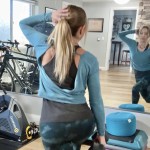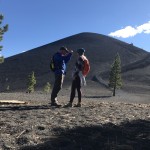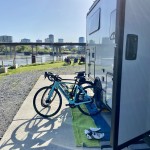This post may contain affiliate links.
So here’s the deal. The last few times I’ve gone out for a ride, I’ve gotten flat tires. Multiple times on the same ride! Sure I carry a spare tube, but just one. That second flat means I have to call Stef, who is not always super excited to stop what she’s doing to come rescue me… Our answer to this problem was to ditch the tubes entirely! We partnered with Trek Bicycle Salt Lake City to bring you this video that shows the entire process:
Mountain bikes have been running tubeless setups and enjoying fewer flats for quite a while now. But going tubeless has recently become more popular and accessible for road bikes, so we finally jumped on the bandwagon. If you’re not familiar with tubeless setups, basically, you set up your bike wheels and tires similar to what you have on your car (or RV!). The system consists of only a few components:
- Tubeless compatible wheels. Ours were the Bontrager Paradigm Elite TLR Road Wheels.
- Tubeless rim strips. This is more substantial than the rim strip tape you may be used to. It has to be, as it forms part of the airtight seal.
- Tubeless compatible tires. We used Bontrager AW2 Hard-Case TLR Road Tires. The two main differences in a tubeless ready tire are the tighter fit and the bead that interfaces with the rim to form a good seal.
- Tubeless valves. They look like a regular Presta valve, only with no inner tube attached.
- Sealant. Naturally, we used Bontrager TLR Tire Sealant. This milky goo is added to the tire and seals up any imperfections or gaps. It also seals punctures as they happen! For months! This is really key for us, and it’s why we expect fewer flats (that we even notice) with this setup.
You can see the whole process in the video. We ask LOTS of questions, and Andy was a great sport in answering all of them for us while still trying to get work done. (I think it would have been a lot quicker if we had just let him work.)
There are also a few products we used and that Andy recommends in the video. Those are:
- The Stans NoTubes Core Remover Tool
- The Dynaplug Tubeless Tire Repair Kit
- The Bontrager TLR Flash Charger Pump
- A Tubless Sealant Injector Syringe
So both Stef and I are riding tubeless now, and we’re really looking forward to fewer flats. (And Stef is particularly excited about fewer rescues…) We intend to come back and update as we’ve had more experience with this setup and report on ride quality, number of flats, that kind of thing. And as we head out in the RV, I’m looking forward to stocking fewer tubes, and being less concerned about what exactly lies down those unfamiliar roads.
UPDATE! IT WORKS!
I didn’t expect to come back with an update so soon, but here I am. On our ride yesterday near Lake Mead, I picked up a construction staple. Heard it tick-tick-tick at first, then saw it when we stopped. We actually had the forethought to make a video before I pulled the staple out! I pulled out the staple, and everything worked and sealed itself up exactly as described. Watch my flat fix itself in this 40 second video:
We rode another 25 miles after that – without even adding air. Is that awesome or what?
Comments or questions? Sound off below. And thanks for watching!











After a couple of years, how are are things going with your road tubeless setup? Any tips or tricks? Anything you’d do differently now that you have a couple years experience under your belt?
Still with it after a couple years, and we have no intention of going back.
The one really big change that we do now that we didn’t in this video is to use the Orange Seal tubeless sealant.
It just works better.
There are more choices in tubless tires these days as well. I’m considering the Continental GP500 tubless tires when it’s time to change.
Thanks for the update, James! You’ve definitely given me the confidence to move forward with road tubeless! Appreciate the recommendation for Orange Seal sealant and the pointer to GP5000 tubeless tires. I’m a big fan of the GP4000; wasn’t aware that the GP5000 was available in a tubeless variant.
It is not as easy as you make it sound – I run tubeless on my mountain bike – and they work great – lets me run lower tire pressure for better traction in the dirt.
However, when the tire pressures increase for road tires tollerences get a lot more criticle – not all tubeless tires will work on all tubeless rims. There is a very fine line of the tire being tight enough to hold at high pressure and being so tight that the tire bead will break when mounting the tire… In addition you are limited in the number of tubeless tires available. My road bike came stock with tubeless tire and rims – the ride was uninspiring so I changed back to my go-to tires Continental Gand Prix 4 seasons with tubes – quality tires = no flats. In the process I realized that even in ideal shop conditions it was extremely difficult to mount tubeless tires – at least 2x’s harder to impossible out on the road… Bottom line – tubeless tires / rims will have less small flats , but with a tube tire you can fix it yourself when you are out on the road – most people will really struggle mounting tubeless tires out on the road. So weigh the options before making the switch to tubeless on road tires…
Hi Skip –
Our regular road tires have been the Continental Grand Prix 4000s for years. So it’s not like we weren’t using a quality tire before.
But yes, the tubeless tires did seem more difficult to mount than “regular” tires. I’m kind of hoping I never really have to experience that along the side of the road. In all my riding, I can only remember having one flat that tubeless wouldn’t have sealed up. And that one was so bad it destroyed the tire anyway and I had to call for a rescue. So I’m mindful of the possibility of having to add a tube out on the road, but I don’t let it worry me too much.
In less than a week, tubeless has already saved one ride, so I’m just going to roll with it.
❤❤❤❤❤ Fantastic all I want for Christmas is this…no more Bike Shops for my grandson…
I’ve been Tubeless on mountain bikes for 15 years and on road bikes for 5. The only major problem is travelling by plane. When you put the bike on the plane you have to deflate your tires. When the tires are deflated they usually pull away from the bead. No problem refilling with a pump like the video or a CO2 cartridge but a real problem if you don’t have one. Remember you cannot take CO2 cartridges on a plane.
Oooohhhh… Good point about the airplane thing! I’m going to be taking that same bike to France in the summer. I’ll have to check into that.
Perfect timing! Just suffered another multiple flat on my trusty antique Bontrager mountain bike. This one resulted in a LONG hike/push out. Have resisted till now but your excellent video has me thinking it’s time for tubeless. However, living in Phoenix that “allot less than 6 month” thing has me concerned. What happens to the sealant inside? Does it dry up? Harden? Does one just keep adding more?
I asked what happens to the sealant. The answer was that it dries up and forms what they call “stanimals”. Google for it, there’s pictures!
I’m kinda OCD about things. I can see myself cleaning the tires out every 6 months. Not certain I will, but it seems like something I’d do.
Been thinking about doing this on my mountain bike, as it came tubeless ready. Says it saves 4 lbs on the bike!
4 pounds? That’s huge!
Must be some heavy tubes. In that case, I’d do it for sure.
Had the shop do it today. It’s awesome. The weight savings on those +1 tires is huge! Even the rims were pre-taped, so it was essentially remove the tubes, put in new stems and the sealant, and air them up.
Awesome!
Enjoy the ride, Ron!
I love technology and how it has changed everything about the sport of cycling but I carry more than one spare tire tube when riding. I know you will be adding air and sealant for your first couple of rides if not more until your tire season’s itself with the rim and tape.
BTW Big Trek is buying up all the independent bike shops here too and now with Fuji owning Performance bike the WAR of retail is on. Its too bad small independent shops will be gone from the landscape soon. But the new challenges come from internet sales and the likes of Canyon of Germany. Sitting back and seeing what happens next with the Trek experiment.
The Trek store in SLC used to be a smaller independent bike shop.
But we’ve had nothing but fantastic experiences every time we’ve been there.
It still feels like a friendly local bike shop.
But one with a LOT more resources behind it!
I hope you have better luck than I with tubeless living in a dry climate as I do in Phoenix. I found the goop rarely lasted more than 2-3 months in Phoenix before drying out. Perhaps those riding in higher humidity regions would fair better. I went back to tubes.
That is a concern for us as well, living in Utah. We’ll post back if our sealant doesn’t last as long as we expect.
You mention that the sealant lasts for “months”. How often will you have to have the tires serviced & the sealant replaced?
I might consider making the switch since I have to get new tires & wheels anyway. (To make a long story short: If you have a tilt down bike rack, don’t put it down at a gas station and then forget to put it back up before driving off. Rear wheel seriously bent, front wheel actually snapped in two.)
NM, now that I actually *watched* the video, I see it’s every 6 months.
Jury is not in yet on the 6 months. But we’re hopeful!
Ouch!!!!
I’ve been tubeless for three years now on road and gravel bikes. It has been great, I would never go back to tubes. 85-90psi road / 38-45psi gravel, I’m 160lbs racing weight. Best of luck on your setup.
Great video, I have Kevlar tube type tires now and they were expensive. Are the tubeless about the same or more expensive?
I thought they were comparably priced.
(But ours aren’t Kevlar!)
i switched to Tubeless at the beginning of spring with mixed results, 8000 km later I went through 3 tires 2 back 1 front.
I did have some punctures, but never had to stop and put air in or had to abandon a ride
I have repaired the tires once I got home several times.
I ran the Schwalbe pro one 700 x 28,I have found them to be great riding fast tires, but fairly fragile.
I have recently switched back to continental gators in for the winter,but would much prefer to run to tubeless all year round, so I would love to hear how these hold up for you
Wow! Sounds like you’re rough on tires.
We’ll respond back with how these work out.
Great stuff. Plus, reason #347 to love James and Stef: they know when to use the word fewer, not less. Bless you, my literate RV/fitness mentors.
Don’t even get me started on the misuse of apostrophes…
😉
Tubeless tires are sooo expensive. I hope these last longer than a normal tire.
We usually get pretty good tires anyway, so we didn’t think these were that expensive. Compared to my old standby (the Continental GP 4000s), these were in the same ballpark.
You have a professional camera crew following you around now? You guys are like the Real Housewives. Superb job, camera crew!
We’ll be sure to tell Leah (one of the Trek store employees who took the time to help us out) that you thought her camera work was awesome!
🙂
★★★★★ Good information
I really wanted to make it a shorter video, but there was so much info the whole way through I couldn’t figure out where to cut it!